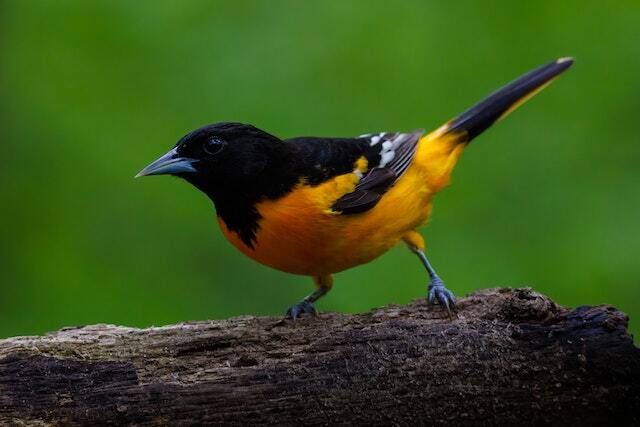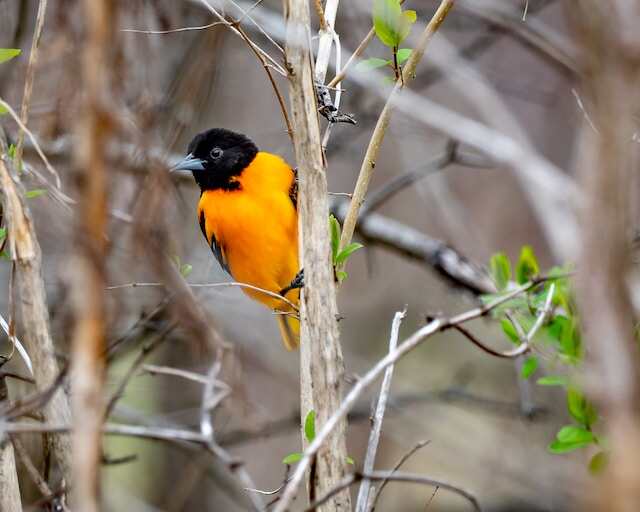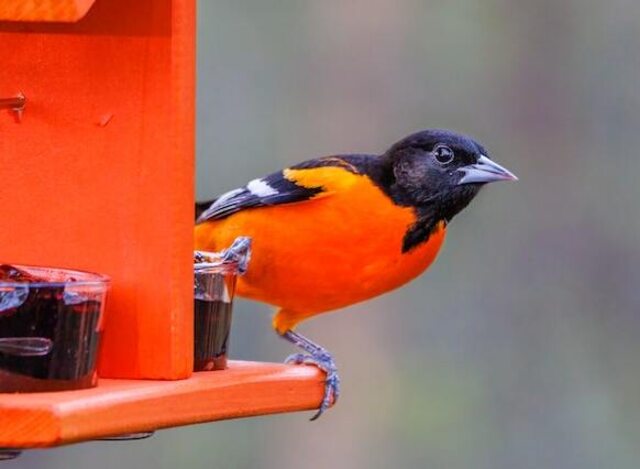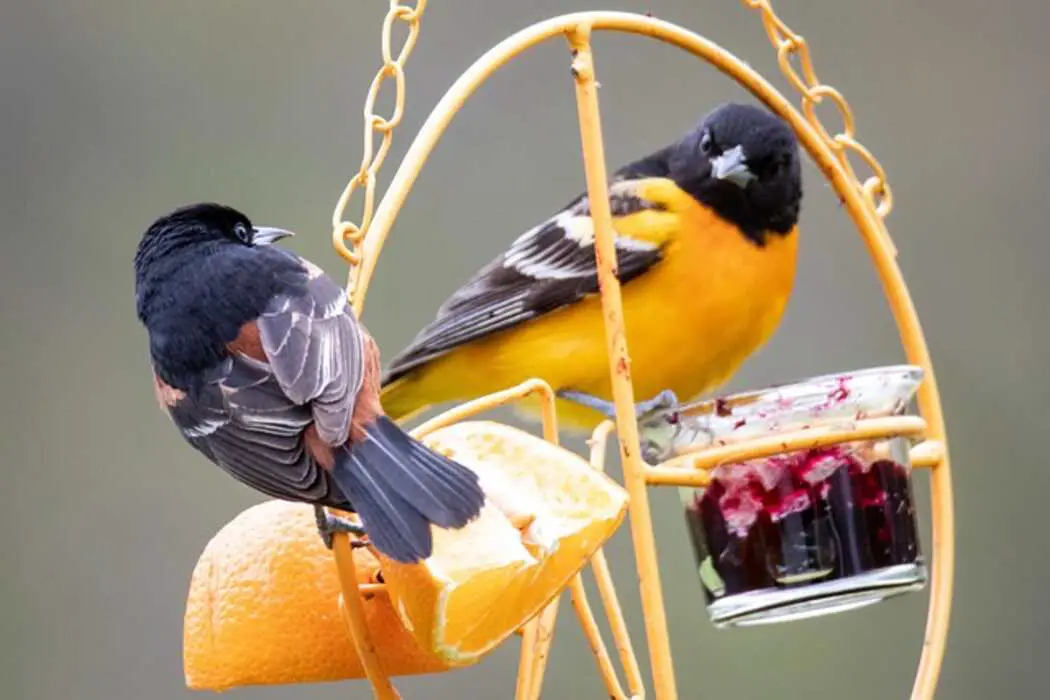Have you ever heard that Baltimore Orioles have a sweet tooth for grape jelly? It’s a common belief that feeding grape jelly to these birds is a great way to attract them to your yard.
However, there is a lot of misinformation out there about what Baltimore Orioles actually eat and whether grape jelly is a nutritious food source for them.
In this article, we’ll explore the diet of Baltimore Orioles and the foods they commonly consume.
We’ll also debunk the myth of grape jelly as a food source for these birds and provide tips for attracting Baltimore Orioles to your yard with a nutritious and balanced diet. So, let’s dive in and learn about what they really eat!
Table of Contents
- 1 Do Baltimore Orioles Eat Grape Jelly?
- 2 The Diet of Baltimore Orioles
- 3 Common Foods Consumed by Baltimore Orioles
- 4 The Myth of Grape Jelly as a Food Source for Baltimore Orioles
- 5 Attracting Baltimore Orioles to Your Yard
- 6 Tips for Providing a Nutritious Diet for Baltimore Orioles
- 7 FAQs
- 7.1 How long do Baltimore Orioles typically live?
- 7.2 What time of year do Baltimore Orioles migrate?
- 7.3 Do Baltimore Orioles only eat fruit, or do they also eat insects?
- 7.4 How can you tell the difference between male and female Baltimore Orioles?
- 7.5 Are Baltimore Orioles attracted to specific types of flowers or plants?
- 7.6 Do robins eat grape jelly?
- 7.7 What birds eat grape jelly besides Orioles?
- 7.8 What birds like oranges and grape jelly?
- 7.9 Do Finches eat grape jelly?
- 7.10 Do Catbirds eat grape jelly?
- 7.11 Do Cardinals eat grape jelly?
- 7.12 What kind of birds eat grape jelly?
- 7.13 Do Sparrows eat grape jelly?
- 7.14 Do Woodpeckers eat grape jelly?
- 7.15 Do Red-bellied Woodpeckers eat grape jelly?
- 7.16 Do Bluebirds eat grape jelly?
- 7.17 Do Purple Finches eat grape jelly?
- 7.18 When to stop feeding Orioles grape jelly?
- 7.19 Do Rose-breasted Grosbeaks eat grape jelly?
- 7.20 Name a Blackbird that eats grape jelly?
- 7.21 Do Red Finches eat grape jelly?
- 7.22 Do Goldfinches eat grape jelly?
- 7.23 Do Blue Jays eat grape jelly?
- 7.24 Do Grackles eat grape jelly?
- 7.25 Michigan birds that eat grape jelly?
- 7.26 Do Bats eat grape jelly?
- 8 Conclusion
- 9 Author
Do Baltimore Orioles Eat Grape Jelly?
Yes, Baltimore Orioles are known to enjoy eating grape jelly. In fact, offering grape jelly is a popular way to attract these birds to backyard feeders. Other fruit-loving birds, such as Bullock’s Orioles, may also enjoy grape jelly as a food source.
However, it is important to note that jelly should be offered as a supplement to a well-rounded diet that includes insects, fruit, and nectar, as birds require a variety of nutrients to maintain their health.

The Diet of Baltimore Orioles
You’ll be fascinated to learn about the diverse range of foods that make up the Baltimore Oriole’s diet. These birds are known to be primarily insectivorous, but they also enjoy fruits, nectar, and even jelly-like substances.
Insects are the most important part of their diet, and they feed on a variety of them, including caterpillars, beetles, and grasshoppers.
They also have a preference for spiders, which they catch by hanging upside down from branches or leaves.
In addition to insects, Baltimore Orioles are also fond of fruits such as oranges, apples, and berries. They are known to visit orchards and berry bushes to feed on ripening fruits during the summer months.
Interestingly, they also have a particular affinity for grape jelly, which is commonly used to attract them to bird feeders.
However, it’s worth noting that although they enjoy jelly as a treat, it should not be their main source of food as it lacks the nutritional value that their bodies need.
Common Foods Consumed by Baltimore Orioles
As a bird lover, you may be curious about the tasty treats Baltimore Orioles enjoy. These birds are known to have a sweet tooth and are often seen sipping on nectar from flowers. However, they also consume a variety of other foods, including fruit, insects, and spiders.
One of the most popular foods among Baltimore Orioles is fruit, especially oranges and grape jelly.
These birds are attracted to the bright colors and sweet scents of fruit, which makes it a perfect addition to their diet.
Grape jelly, in particular, has become a favorite among bird enthusiasts who often put out feeders filled with the sweet spread. So, if you’re wondering if Baltimore Orioles eat grape jelly, the answer is yes!

The Myth of Grape Jelly as a Food Source for Baltimore Orioles
Don’t be fooled by the myth that grape jelly is a reliable food source for these birds, as it should only be offered in moderation and as a supplement to their natural diet.
While grape jelly may attract Baltimore Orioles to your backyard, it does not provide them with the necessary nutrients they need to thrive.
Orioles primarily feed on insects, nectar, and fruit, with insects making up the majority of their diet.
Offering grape jelly in moderation can be a fun and enjoyable way to attract these beautiful birds to your yard, but it should not be the sole source of their nutrition.
It is important to provide a variety of foods that mimic their natural diet, such as oranges, mealworms, and sugar water.
By offering a diverse range of foods, you can help ensure that Baltimore Orioles stay healthy and happy in your backyard.
Attracting Baltimore Orioles to Your Yard
If you want to create a welcoming environment for these vibrant birds, it’s important to provide a diverse range of foods that mimic their natural diet. Baltimore Orioles primarily feed on nectar, fruit, and insects.
To attract them to your yard, you can set up a feeder with a nectar solution, offer fresh fruits like oranges and cherries, and provide a source of protein with mealworms or suet.
It’s also important to create a suitable habitat for Baltimore Orioles. They prefer areas with mature trees, especially those with dense foliage, for nesting.
You can plant native trees and shrubs like dogwood, serviceberry, and elderberry to provide a natural habitat.
Additionally, providing a shallow water source like a bird bath can also attract these beautiful birds to your yard.
By providing the right foods and habitat, you can create a welcoming environment for Baltimore Orioles to visit and possibly even nest in your yard.

Tips for Providing a Nutritious Diet for Baltimore Orioles
To make your yard a feast for the eyes and a haven for Baltimore Orioles, give them a varied and nutritious diet of sweet nectar, juicy fruit, and protein-packed insects like mealworms.
While some people may wonder if Baltimore Orioles eat grape jelly, it is not necessary to rely solely on this sugary treat as their main source of food.
In addition to grape jelly, Baltimore Orioles enjoy other types of fruit such as oranges, apples, and bananas.
They also love nectar from flowers and hummingbird feeders, as well as protein-rich insects like mealworms and crickets.
By providing a diverse and balanced diet, you can ensure that these beautiful birds have the energy and nutrients they need to thrive in your yard.
FAQs
How long do Baltimore Orioles typically live?
Baltimore Orioles typically live for about 8–10 years in the wild. These birds are known for their bright orange plumage and beautiful songs.
They are migratory birds and spend their winters in Central and South America, returning to North America in the spring to breed.
Orioles have a varied diet that includes insects, nectar, and fruit, but there is no evidence to suggest that they eat grape jelly specifically.
Providing a jelly feeder in your yard may attract orioles, but it is important to remember that this should be offered as a supplement to their natural diet, not a replacement.
What time of year do Baltimore Orioles migrate?
Baltimore Orioles are known for their beautiful bright orange plumage and sweet melodic songs. These birds are migratory, and typically migrate twice a year.
In the springtime, they fly north to breed and raise their young, and in the fall, they fly south to escape the cold, harsh winter temperatures.
The timing of their migration can vary based on a number of factors, including weather patterns and food availability.
However, on their journey, they are not known for eating grape jelly, despite popular belief. Instead, they primarily feed on nectar, fruit, and insects.
Do Baltimore Orioles only eat fruit, or do they also eat insects?
Baltimore Orioles are known for their love of sweet fruits, particularly oranges and grape jelly. However, contrary to popular belief, they also feed on insects such as caterpillars, spiders, and beetles.
In fact, insects make up a significant portion of their diet during the breeding season, when they need to provide protein-rich meals for their young ones.
So, while they do enjoy snacking on sugary treats, Baltimore Orioles have a varied diet that includes both fruits and insects.
How can you tell the difference between male and female Baltimore Orioles?
To distinguish male and female Baltimore Orioles, look for differences in plumage and size. Males have bright orange plumage with black wings and a black head, while females have duller orange-yellow plumage with grayish wings and a grayish head.
Additionally, males tend to be slightly larger than females. It’s important to note that Baltimore Orioles primarily feed on insects and fruit, and while they may occasionally eat grape jelly from feeders, it should not be a major part of their diet.
Are Baltimore Orioles attracted to specific types of flowers or plants?
Baltimore Orioles are known for their love of nectar and fruit, making them frequent visitors to gardens with flowers and fruit trees. They are especially attracted to bright, bold-colored flowers such as trumpet vine, honeysuckle, and bee balm.
Orioles also enjoy eating insects and spiders, which they catch by hovering and darting through foliage. Providing a source of fresh water, such as a birdbath or fountain, can also attract these beautiful birds to your yard.
Do robins eat grape jelly?
Yes, robins do occasionally eat grape jelly, especially if it’s available in their environment. While they primarily feed on insects and fruits, they may sample grape jelly from time to time.
What birds eat grape jelly besides Orioles?
Many birds, including catbirds, woodpeckers, and some finches, may consume grape jelly. Orioles are known for their preference, but other species are attracted to it as well.
What birds like oranges and grape jelly?
Orioles are particularly fond of oranges and grape jelly. They are the most common birds that enjoy this combination of foods.
Do Finches eat grape jelly?
Some finches, like house finches and purple finches, may occasionally sample grape jelly if it’s accessible. However, they typically prefer seeds.
Do Catbirds eat grape jelly?
Yes, catbirds are known to eat grape jelly. They have a diverse diet that includes fruits, insects, and some other food items.
Do Cardinals eat grape jelly?
Cardinals are not known to be regular consumers of grape jelly. They generally prefer seeds, fruits, and insects.
What kind of birds eat grape jelly?
Orioles, catbirds, woodpeckers, and some finches are among the birds that may eat grape jelly, although their preferences vary.
Do Sparrows eat grape jelly?
House sparrows might taste grape jelly, but it’s not a typical part of their diet. They mainly consume seeds and grains.
Do Woodpeckers eat grape jelly?
Woodpeckers, like the northern flicker, are known to occasionally consume grape jelly, particularly if they’re attracted to it.
Do Red-bellied Woodpeckers eat grape jelly?
Yes, Red-bellied Woodpeckers are known to occasionally eat grape jelly, especially if it’s offered in bird feeders. They have a diverse diet that includes insects, fruits, and seeds, making grape jelly an attractive treat for them.
Do Bluebirds eat grape jelly?
Eastern bluebirds generally prefer insects, fruits, and berries over grape jelly. They are not commonly associated with eating jelly.
Do Purple Finches eat grape jelly?
Purple finches may try grape jelly, but it’s not a primary part of their diet. They primarily consume seeds.
When to stop feeding Orioles grape jelly?
You should stop feeding orioles grape jelly when they have migrated south for the winter. In colder months, they won’t visit feeders for jelly.
Do Rose-breasted Grosbeaks eat grape jelly?
Yes, Rose-breasted grosbeaks may consume grape jelly, especially during their migration period when they appreciate the extra energy.
Name a Blackbird that eats grape jelly?
Common grackles are blackbirds known to consume grape jelly. They have a varied diet and can be attracted to feeders.
Do Red Finches eat grape jelly?
Red finches, like house finches, may occasionally taste grape jelly, but it’s not a primary part of their diet. They prefer seeds.
Do Goldfinches eat grape jelly?
Goldfinches are not typically attracted to grape jelly. They prefer seeds, especially thistle seeds.
Do Blue Jays eat grape jelly?
Blue jays may eat grape jelly if it’s available, but they are more commonly associated with nuts, seeds, and insects.
Do Grackles eat grape jelly?
Yes, common grackles are known to eat grape jelly. They have a varied diet and can be attracted to jelly feeders.
Michigan birds that eat grape jelly?
Michigan hosts a variety of birds that may consume grape jelly, including orioles, woodpeckers, and some finches.
Do Bats eat grape jelly?
No, bats do not typically eat grape jelly. Their diet primarily consists of insects, fruits, and nectar.

Conclusion
In conclusion, while grape jelly may be a popular option for attracting Baltimore Orioles to your yard, it is not a nutritious or natural food source for these birds.
Instead, providing a varied diet of fruits, insects, and nectar will ensure that Baltimore Orioles stay healthy and happy in your yard.
Additionally, planting native plants and avoiding the use of pesticides will create a more natural environment for these birds to thrive in.
By taking these steps, you can enjoy the beauty of Baltimore Orioles while also promoting their overall well-being.


